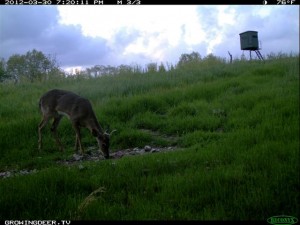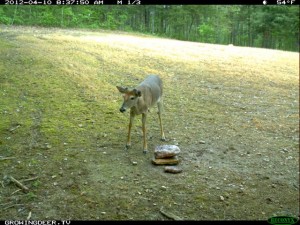Category: White-tailed Deer
Are You Seeing Antlers?
“Are you seeing antlers?” This time of year that question almost always means seeing bucks that have started growing a new set of antlers. However, that’s not the case this year. Due to the record warm winter and significantly lower than normal stress levels on deer, many bucks throughout the whitetails’ range are still holding antlers from the 2011-12 season.
At The Proving Grounds we got Reconyx images last week of bucks still holding antlers from last season and bucks that have shed and are starting to grow new antlers. I’ve even had a report of an image from Iowa of a buck that still has his antlers from last year and is starting to grow new antlers off to the side. That has happened before – but it is very odd.
I don’t know (and I doubt anyone does) what all this means as far as antler growth this summer. I strongly suspect the growing conditions this summer will be more of an influence on antler production more than the odd shedding pattern that is occurring. I’m very eager to see how antlers develop this summer! I would appreciate seeing trail camera images of bucks that haven’t shed as of today (April 13th). I’d also really appreciate any trail camera images of bucks that are growing their new antlers while still holding antlers from last year. (You can upload the images directly to my Facebook page.)
Odd years produce odd results. I’m eager to see how the average antler production during 2012 turns out!
Growing Deer (and learning) together,
Grant
Pt. 4: Top 10 Recommendations for Managing Land to Yield Mature, Huntable Deer
Part 4: Adult Sex Ratio
In this blog I’ve been addressing a question posted on my Facebook page. The question was “What are your top 10 recommendations for managing land to yield mature, huntable deer?” During recent blogs, I’ve described the importance of age, nutrition, and cover in managing land to yield mature, huntable bucks.
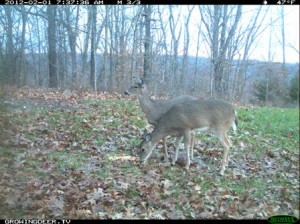
Two does
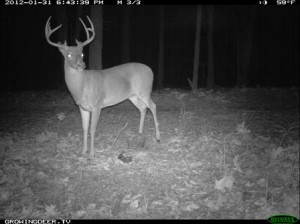
Buck near a Trophy Rock
If you’ve read those blog entries, it is obvious that reducing stress is a common theme to achieve the goal of managing for mature, huntable bucks. An equally important herd characteristic that should be managed is the adult sex ratio. The adult sex ratio is simply the number of bucks to does that are at least 1.5 years old. If a herd was composed of five bucks and ten does that were 1.5 years old or older, that herd’s adult sex ratio would be 1:2.
The adult sex ratio has several implications on the herd’s health and huntability, especially for mature bucks. It is common for a buck to attempt to tend a doe before she is receptive and remain near her for 24-48 hours. While he is “tending” that doe, other does may also be receptive. In fact, if the herd’s adult sex ratio is skewed heavily toward does, some does may cycle through their receptive period without being bred.
This results in them becoming receptive again about a month later. When this occurs, it means she will produce fawns a month later (or more if she cycles multiple times). This results in fawns being born later when conditions for fawning are probably not as favorable. As the summer progresses forage quality tends to decrease, insect loads become higher, the temperatures become higher, etc. Simply stated the conditions for prospering as a fawn tend to decline as the summer progresses.
Deer probably won’t express their full potential as an adult if they didn’t have all the required resources as a fawn. In addition to providing good quality forage (nutrition) and cover, it is just as important to ensure the adult sex ratio is balanced so the majority of fawns will be born during the optimal time for growth and reduced stress.
The older age classes also benefit from being part of a herd with a balanced adult sex ratio. It is very stressful for mature bucks to participate in the rut. Captive bucks in relatively small enclosures (less than five acres) and that have access to all the supplemental feeds they can consume have been reported to lose +/- 30% of their body weight during the rut. Given this, imagine the cost of participating in the rut for free-ranging wild bucks that must search for quality food, be constantly alert for two and four legged predators, and face all the daily challenges that captive deer avoid. In addition to the challenges of surviving, if a buck is part of herd where the adult sex ratio strongly favors does, the duration that he will seek, chase, and tend does is greatly extended simply because some does will not be bred during their first receptive cycle.
Likewise yearling bucks that are not fully mature will seek, chase, and tend receptive does as mature bucks are occupied with other receptive does. Yearling bucks would most likely develop better if they were dissuaded from chasing does by the presence of mature bucks (and their pheromones). Immature bucks need a huge amount of resources simply to maintain skeletal and body growth. The resources expended by participating in the rut may well limit the resources available for skeletal and body growth.
Likewise, it takes resources for does to cycle through her receptive period multiple times and nurture a fawn or fawns past the prime fawn rearing season.
Bucks, does, and fawns simply do best when they are born and rut during a natural timeframe and cycle. The best tool to ensure your herd is breeding and fawning at the optimal times is to manage the herd for a balanced adult sex ratio and ensure the population doesn’t exceed the habitat’s ability to supply quality forage.
In addition to a healthier herd, another huge benefit to managing for a balanced adult sex ratio is that that competition for breeding will likely be more intense and therefore bucks may be more active and most likely hunting strategies such as calling, rattling, using decoys, etc. may be more effective than in herds where there is not as much competition during the rut.
A great tool to manage your land to yield mature, huntable bucks is to establish and maintain a herd with a balanced adult sex ratio.
Growing Deer together,
Grant
Lockdown Rut Phase
I grew up hearing and thinking the rut was the best time to hunt big bucks! Like most subjects, the more you learn, the more you use the terms “however,” “but,” and “if.” As I learned more about hunting and deer biology, the term “rut” got replaced with “pre-rut,” “the chase phase,” “lockdown,” and “post rut.” As I began understanding the facts and theories about these phases of the rut, I learned just how much site specific deer management impacts the behavior of local deer herds.
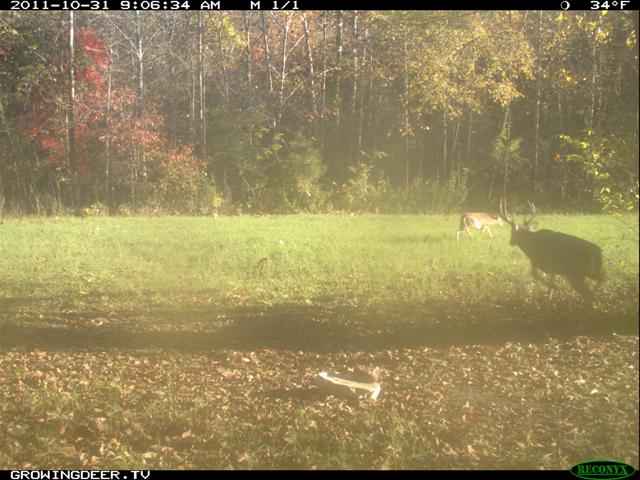
Big, mature buck chases a doe during chase phase of the rut.
I live and do most of my hunting in southwestern Missouri. In fact, I hunt primarily in Stone and Taney counties of Missouri. No matter where you hunt, herds with a higher number of mature bucks in combination with a balanced adult sex ratio usually provide better deer hunting. Bucks in these herds tend to respond to rattling, grunt calls, decoys, etc., better. There seems to be more activity during daylight hours (given the same weather conditions).
The best hunting is where a balanced adult sex ratio and older age structure exists among bucks for a large geographical area. The larger the area the better! However, the quality of hunting (as far as interacting with deer expressing all phases of the rut ) can be improved. Even on smaller acreages where deer ranges tend to overlap the property lines on neighbors that still practice “if it’s got horns, shoot it.”
In that scenario, the best hunting is usually during the later stages of the pre-rut or the chase phase of the rut. This is when bucks are searching for does, but the does are not receptive yet. Therefore, the bucks tend to be on their feet more hours throughout the day.
When a majority of the does are receptive, many of the bucks (young and old) will be paired up with a receptive doe for 24-36 hours. Often times a dominate buck will stay within 10 yards of a doe while subordinate bucks stay in the area trying to sneak in for a date. Does rarely move much in this situation, so the bucks don’t cover much ground either. When the peak of breeding is occurring, hunters are less likely to see deer.
I’ve heard from several of my hunting buddies from South Carolina to Kansas during the past few days and none of them are reporting seeing many deer. It appears many deer herds are currently in the lockdown phase of the rut.
I’ll keep hunting, but I’m looking forward to the post rut when once again just a few does are receptive and mature bucks are cruising trying to find a date and feeding. There’s another peak of mature buck activity coming and I’m eagerly waiting. I’ll share with you what I know from a hunter’s and scientist’s point of view next week.
Growing Deer Together,
Grant
The Chase Phase of the Rut
Mature bucks are beginning to chase does throughout much of the whitetail’s range. It’s a time of year that literally millions of deer hunters schedule their vacation and with good reason.
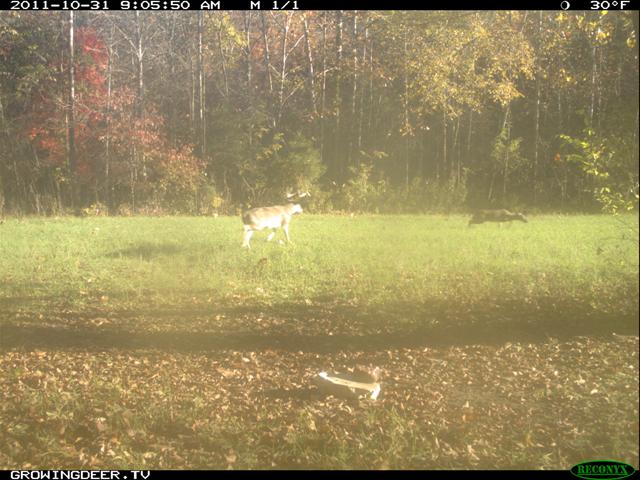
A big, mature buck chases a doe
If you hunt close to home, you can pick days to hunt when a weather front is passing, or you’ve found a limited resource such as a pond during drought that deer are actively using. However, if you are traveling to hunt then the chase phase allows you to plan a year in advance and puts the odds in your favor that mature bucks will be active during daylight hours. During the chase phase of the rut mature bucks tend to be active during the daytime even if the hunting pressure or air temperatures are a bit higher than normal.
The October Lull phase of deer activity just passed. This is when deer, especially mature bucks, have grown their winter coat and food is usually plentiful. Deer don’t have to travel far to find food, and they aren’t burning many calories to stay warm or chase does. Mature bucks simply don’t have many reasons to move during daylight in mid-October in most regions.
However, with each passing day now more and more does will become receptive. Bucks will be moving in search of the few does that are receptive. For the next several days, more and more does will become receptive until the peak of breeding activity. During the peak of breeding activity, most mature bucks will stay with a receptive doe for about 24 hours. This is called the Lock Down phase of the rut. During this time, mature bucks typically only move when they are finished tending one receptive doe and are seeking another.
The woods can seem almost void of deer during the Lock Down phase. This is because it’s not only the mature bucks that tend does. In fact, multiple research projects have now shown that mature bucks only breed slightly more does annually than immature bucks. Not many deer will be moving when most of the does are receptive and most of the bucks can have a date.
In addition, the duration and intensity of each phase of the rut varies location by location based on the herd’s adult sex ratio and health. Herds with a balanced (or skewed toward bucks) adult sex ratio seem to have the most intensive rutting behavior. There’s much more to the science than what I’ve shared here.
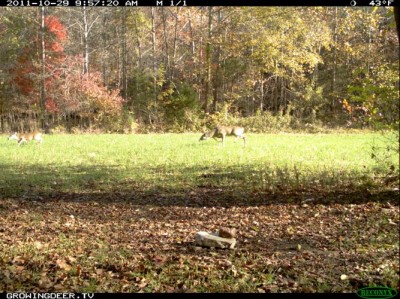
A Buck Chasing A Doe During The Chase Phase of the Rut
So, if you enjoy hunting the chase phase of the rut, get out the door! It’s time to go hunting! If you choose to plan ahead for your hunting vacation next year, the first and second week of November is usually a good option for hunting mature bucks in most areas of the whitetail’s range. There are other times of the year that can be very productive, but they are very weather dependent. The local weather can’t be predicted accurately enough to plan vacation time months ahead. However, weather isn’t as big of a factor during the chase phase of the rut, so it’s the safest bet for scheduling hunts that require packing a suitcase!
Growing Deer together,
Grant
Big Bucks and Late Frost
Most of my hunting buddies throughout the whitetails range are talking about the slow start to the 2011 hunting season. Sure there have been some great bucks harvested, but the season seems slow overall. I was hunting yesterday and watched a yearling and a two year old buck work a scrape. However, I’m not seeing as many scrapes as normal for this time of year. Scrape behavior is not the only thing that is late this fall. It hasn’t frosted yet in southern Missouri, Kentucky, etc. The normal frost date for that latitude is about October 10-15. There is no frost predicted in the seven day forecast. It seems there is usually a burst of deer (and deer hunter) activity when the first strong cold front occurs.
There is not a tested and proven scientific reason to why deer tend to move more when the first strong cold front occurs each fall. However, I think it is as simple as deer having their winter coat and not being as comfortable moving when the air temperature is warm. In addition, before the first frost, many forage plants are still growing which means there are multiple sources of food. Once the temperatures decrease significantly, I suspect it is more comfortable for deer to be active. In many areas, they will have to search for food more as some sources of forage were killed or became unpalatable after the frost. I want the bucks where I’m hunting to feel the need for more fuel. For this reason and more, I always welcome the first frost.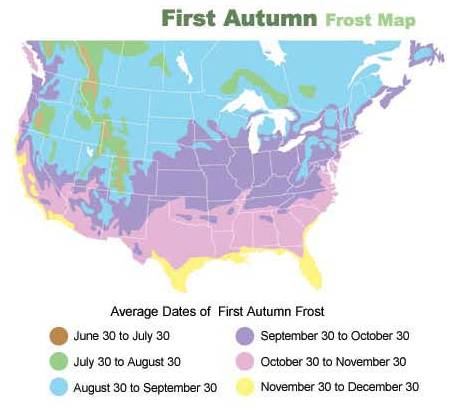
On the other hand, it has recently rained at my place. The wheat I had planted has germinated and grown some, but not much. Another week without a frost will allow the wheat to produce many more pounds of forage. That will make for some great hunting later this season and provide more high quality forage for the local deer herd. So from that point of view, I’m glad it hasn’t frosted yet.
I’ll go hunting whether it frosts or not. However, I don’t plan to hunt my best stand locations until a weather change occurs and I believe daytime deer activity increases. It’s always tough to schedule a vacation to hunt a critter whose daytime activity level is so tied to the weather – which can’t be accurately predicted more than a few days in advance.
When the first cold front occurs, I suspect I’ll stop hearing from some of my hunting buddies. They will be too busy hunting to visit – and so will I.
Growing Deer together,
Grant
Deer Hunting and Scent Control: How Good is a Deer’s Nose?
Most hunters know that deer have a great sense of smell. However, it is very difficult for researchers to determine just how good a deer’s sense of smell is. We can’t put samples in front of a deer and ask them if they can detect this odor or chemical. However, earlier this week I indirectly witnessed an example of how well deer can smell.
I shot a doe in the liver with my bow. I reviewed the footage on a high quality HD camera (we were filming for GrowingDeer.tv). I knew the hit would be fatal, but the trailing job would be a bit longer than a deer shot in both lungs. We waited an hour then took up the trail, which was easy to follow for the first 100 yards. The doe then traveled through a grove of cedars and blood doesn’t show up very well on cedar needles. In Missouri, all possible means to recover a deer must be used before using a dog to trail. I felt we were at that point so I called the local conservation officer and obtained permission to use Crystal, our 18 month old lab. Tracy, my wife, has been training Crystal to follow blood trails.
Crystal was a bit confused at first given all of my scent, but eventually she picked up the trail. She trailed the doe through the cedars, across a food plot, across a dry creek, through chest high weeds along the creek, down a gravel road for 100 yards, then 50 yards into a thick bedding area. I was thrilled to see the doe piled up and gave Crystal several treats and plenty of “good girl” comments!!
Besides being thrilled to recover the doe, I was once again shown how well deer can smell. It’s generally assumed that prey species (deer included) have as good, if not a better, sense of smell than predator species (Crystal included). This is one reason prey species are able to survive.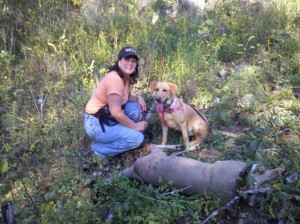
Several vehicles had driven the gravel road between when I shot and when Crystal trailed the doe down the gravel road. The humidity was low that day and because gravel is not porous it is not a good surface to hold scent. The gravel had been covered by vehicle exhaust, dripping oil, etc. Neither I, nor the folks helping, saw one drop of blood on the gravel road. Simply stated, Crystal was able to trail the deer in horrible conditions.
I share this event to illustrate how good a deer’s sense of smell is. It’s incredible! Based on this and gads of other similar observations, my hunting strategy has changed over the years to include reducing as much scent from my gear and myself as much as possible.
I start with a shower. I then dry myself with a clean towel that’s been laundered in scent free soap. My hunting clothes have been laundered with scent free soap also and stored in a barn that doesn’t have gas, etc., stored close by. I take my hunting clothes and gear to the field in clean tubs and change into them beside my truck just before I walk to my stand. Yes, it can be wicked cold changing in the field during the late season. I have a pair of boots I only use when I hunt. I never wear them inside my truck, let alone to go shopping, get gas, etc. I use the Dead Down Wind system because it is based on enzymes that destroy chemicals and bacteria that are the source of odors. Most scent control systems are only a bactericide – just one source of odors.
The effort involved to take these steps is worth it to me as I frequently watch deer cross the path I use to access my stand. In fact, I watched multiple deer cross the path the cameraman and I used to access my stand this past Wednesday, when I harvested two does. Multiple deer fed 270 degrees around the stand without giving any indication they smelled Adam (the cameraman), me, or our gear. It was a beautiful morning in the woods watching deer and bringing home some venison. I believe it occurred because Adam and I use a simple, but effective scent reduction system.
A deer’s sense of smell is amazing. However, by reducing the scent on me and my gear as much as possible by using a complete system, I have shown that I can keep from alerting deer to my presence. This is critical in the humid, swirling wind conditions where I live and hunt. During bow season, controlling my scent enough that deer may approach 10 yards closer can lead to more opportunities to draw back my bow.
I like watching Crystal work, but would rather watch her trail someone else’s deer. I’ll keep using my system and let my buddies know Crystal is available if they make a bad hit.
Growing Deer together,
Grant
Antler Growth Patterns
Every year at this time I receive several questions related to how much more antler growth will occur. Folks want to know if a mature buck can add another 20” before velvet shed or what percent of antler development will occur still yet this year.
There is no certain answer for these questions. There are simply too many variables. Two of them are easy to describe. I was one of the tallest kids in my first grade class, if not the tallest. Everyone wanted me on their basketball team during recess. However, by the time I was a freshman in high school, I was only slightly above average height (I’m a tad over 6’ now). No one was screaming for me to be on their basketball team then. Some kids that I was much taller than in first grade were inches taller than me in high school.
I share this information not because I wish to play basketball, but as an illustration about antler development. Some bucks tend to grow more during the early portion of the antler growth season and some add a significant amount of inches during the last few weeks before velvet shed. On average, most bucks are finished adding a significant amount of antler by mid August. However, each buck is a unique individual just like humans are each unique. The best we can do is to manage based on the averages.
Another factor is the growing conditions. The severe drought that is impacting many states throughout the whitetails’ range could certainly limit antler development. Bucks that are feeding on irrigated crops may not show as much reduction in antler development as bucks that live where crop production is extremely limited by lack of water and heat stress.
The other extreme is also true. Bucks that live in areas with a closed canopy forest or other areas where growing season forage is extremely limited may not have significantly less antler development this year compared to normal growing conditions as there simply isn’t much quality forage to limit no matter what the conditions.
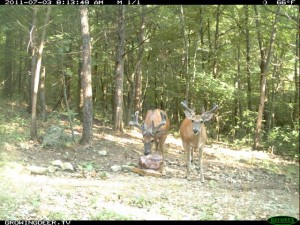
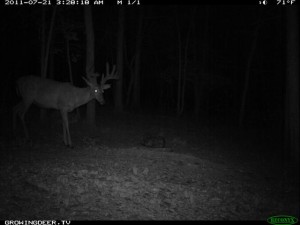 At The Proving Grounds, based on trail camera images, it does seem some of the mature bucks didn’t produce much more antler from last week to this week. I feel comfortable this is because of the extremely harsh drought conditions. The two images are of a buck I named Heavy 10. The images are about 1 week apart, but I can’t tell any increase in antler development. I’ll keep monitoring Heavy 10 and the other bucks for antler growth patterns. How are the bucks developing on your property?
At The Proving Grounds, based on trail camera images, it does seem some of the mature bucks didn’t produce much more antler from last week to this week. I feel comfortable this is because of the extremely harsh drought conditions. The two images are of a buck I named Heavy 10. The images are about 1 week apart, but I can’t tell any increase in antler development. I’ll keep monitoring Heavy 10 and the other bucks for antler growth patterns. How are the bucks developing on your property?
Growing Deer together,
Grant
A Spring Stressor for Me and the Deer Herd!
Brad had the following observations to share after running the trail cameras earlier today. – Grant
It’s raining cats and dogs here today at The Proving Grounds, a welcome sight since we were able to get all of our soybeans and corn planted earlier this week. Spring is the time of the year when we typically think deer have little stress due to the abundance of lush/nutritious native forage. The deer herd can definitely keep their belly full, but there are still plenty of stressors during this time of the year. The stressor that disturbs us every spring is the presence of a wad of ticks behind the ears of our bucks and does.
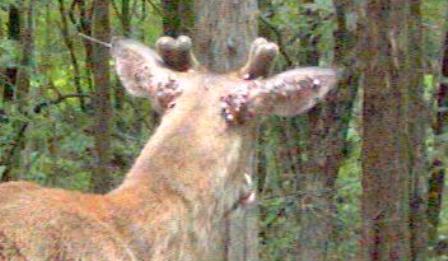
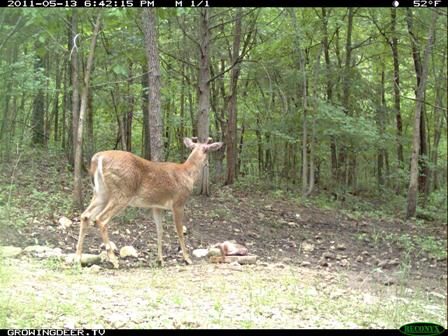 The area directly behind the deer’s ear is one of the few places on their body that the removal of unwanted ticks is difficult. If they do happen to find a way to scratch them off their skin often gets opened allowing for the possibility of infection.
The area directly behind the deer’s ear is one of the few places on their body that the removal of unwanted ticks is difficult. If they do happen to find a way to scratch them off their skin often gets opened allowing for the possibility of infection.
Ticks, as you can imagine, are also directly pulling from a deer’s energy and nutrient supplies. These resources are needed for developing antlers and rapidly growing fetuses. Not to mention the constant irritation can distract them from predator avoidance and normal foraging behavior.
The best method I know of to beat down tick populations is to keep a burning rotation going from year-to-year. Ticks are not easily consumed by the fire itself because they can burrow under debris or loose soil to escape the heat. However, they are susceptible to desiccation – or drying out. With much of the herbaceous and woody material removed, the soil surface can heat up more and lower ground level humidity levels cause ticks to die. In addition, ticks picked off are not simply flicked to the side or out the truck window, they meet their demise between a finger nail and a hard place or at the strike of a match.
I hope your deer are not suffering from ticks on your Proving Grounds, but if so consider implementing prescribed fires to help reduce their presence. It may pay dividends toward more venison in the freezer and larger antlers on the wall.
Growing Deer together,
Brad
Listening Allows Me to Give the Best Counsel
I worked a few properties in South Carolina earlier this week. They were located in the Piedmont of South Carolina where the pine tree is the predominate crop and land cover! These properties were primarily pine forest, with a few acres of food plots. The landowner and his regular guests reported observing deer in the plots on a regular basis. They really enjoyed seeing deer, and really enjoyed consuming the meat and sharing the hunting opportunities with their children and friends.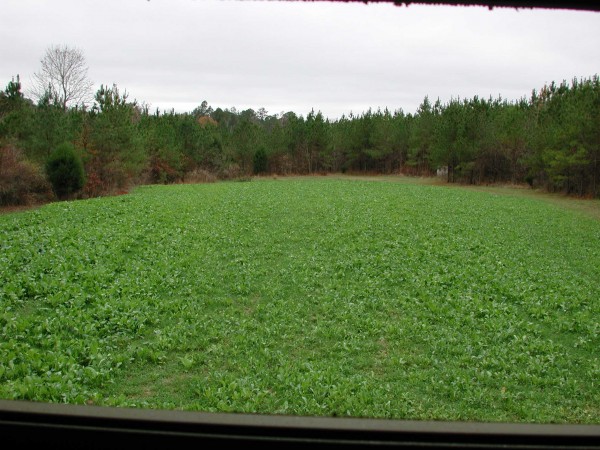
Working this property reminded me that hungry deer are easy to hunt. This is not a new principle. A very successful hunting strategy is to determine a limiting resource (food, cover, or water) and when deer are using that limiting resource. In this case, food was clearly the limiting resource. There were miles and miles of closed canopy pines (both private and industrial owned) and a few interspersed fescue pastures. There were no row crops or other cultivated crops within the likely range of a deer. Hence the primary source of quality and palatable food were the plots on my client’s property. Hence my client knows exactly where to hunt. From experience, he had learned how to approach each plot based on the predicted wind direction to limit disturbance to the local deer herd. As a result he reported seeing multiple deer almost every time he went hunting.
Because he had identified the limited resource and how to hunt it without disturbing deer, he and his guests have been extremely successful at observing and harvesting deer. I warned him that after he implements the habitat improvements I recommended, the quality of the deer should increase, but the quality of his hunting, measured by number of deer observed, may decrease.
I created a plan to thin the timber significantly so there would be sunshine reaching the forest floor. This action paired with a treatment of herbicide and prescribed fire to control hardwood saplings should result in a huge increase in the quality and quantity of native browse production. This means there will be quality food throughout the property, not just in the food plots. In addition, my plan included significantly increasing the acres of food plots and changing what he planted from solely winter annuals to forage soybeans during the summer and winter annuals during the fall (if the deer consumed the beans before they produced pods). It may take a season or two to get the deer density/forage production ratio balanced.
I’m extremely confident if he implements my habitat recommendations, the herd’s quality will increase. However, I’m not sure his observation rate will increase. We will use a trail camera survey to monitor the herd’s population trends. However, monitoring the satisfaction of the client will be through direct observation and conversation. I was confident in my proposal based on detailed and repeated conversations about his deer management and hunting goals and objectives. It is critical to listen to their objectives. Listening often allows me to give the best counsel.
Growing Deer together,
Grant
Finding Skulls vs. Sheds
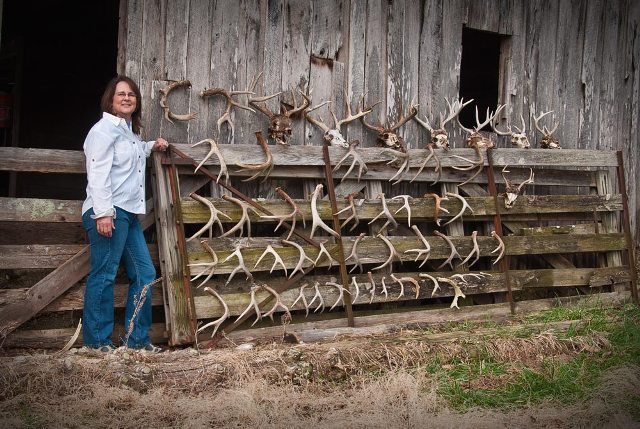 The 2nd Annual Shed Hunt at The Proving Grounds occurred last weekend. We had identified 96 bucks using Reconyx cameras during the 2010-11 season. To date this spring we have found 60 antlers, including seven skulls. That’s almost a third of the antlers that could be on the property! I think that is a huge success considering:
The 2nd Annual Shed Hunt at The Proving Grounds occurred last weekend. We had identified 96 bucks using Reconyx cameras during the 2010-11 season. To date this spring we have found 60 antlers, including seven skulls. That’s almost a third of the antlers that could be on the property! I think that is a huge success considering:
- Some of the bucks are still carrying their antlers based on recent trail camera images.
- Some of the bucks were harvested on neighboring properties.
- Some of the bucks most likely shed on neighboring properties.
- Coyotes and other critters have probably moved or consumed some sheds.
The shed hunt attendees all understood these factors and joined us in celebrating the success of our hunt!! However, there were questions about the number of skulls (7) found. All of the carcasses we found were totally decomposed or consumed. There were only skeletal remains and most of the smaller bones like ribs had been consumed by predators. Therefore there was no evidence as to the cause of death.
There are gads of causes of mortality for deer. In most areas, the most common cause of death is hunting. Predation by coyotes is a close second (and maybe the primary cause of death) in some areas. Deer also are commonly killed by vehicles (not a common cause of death at The Proving Grounds as there is very little road frontage). Deer die as a result of injuries from fighting. Often wounds they receive from fighting become infected. Deer are wounded by hunters and are not recovered.
The bottom line is that non-hunting mortality is a huge factor in deer management. The rate varies from property to property. Good managers learn to account for the non-hunting mortality at their properties and adjust the hunter harvest accordingly. We found 60 total antlers this year at The Proving Grounds, 14 attached to skulls. That means there were 46 sheds (a minimum of 23 bucks, but not all the sheds we found were matches). Taking into account the single sheds we found, it appears we had a 20% non-hunting mortality rate. I expect that is a bit high. Remember, skulls are easier to find than sheds because they are larger and simply easier to observe.
Research from Mississippi State indicated that in the herd they were studying there was about 10% non-hunting mortality annually. That number is probably higher now given that coyote populations are much higher in many portions of the whitetails’ range. So, don’t be surprised if you find about 10% or more skulls. Shed hunting is just another fun tool managers can use to monitor a deer herd.
Growing Deer together,
Grant



